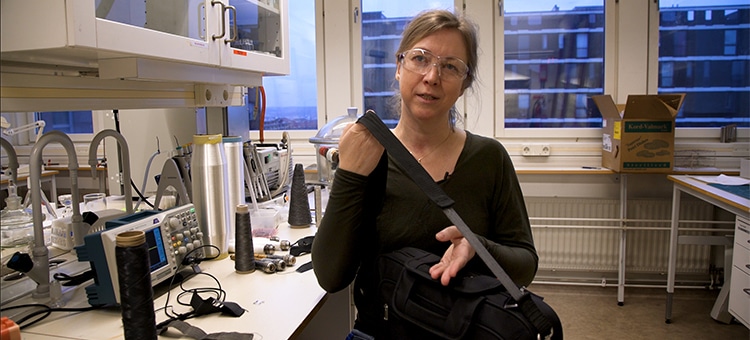Mar 30 2018
Carrying a heavy load can be extremely difficult. This is exactly when the textile functions at its best. In association with the Swedish School of Textiles in Borås and the research institute Swerea IVF, scientists at the Chalmers University of Technology have designed a unique fabric that can convert kinetic energy into electric power.
When more amount of load is applied to the textile, it becomes wetter and generates more electric current. The results of the study have been reported in the Nature Partner journal, Flexible Electronics.
 Anja Lund with a piece of the electric textile in the shoulder strap of a bag (the lighter-colored part). (Image credit: Chalmers University of Technology)
Anja Lund with a piece of the electric textile in the shoulder strap of a bag (the lighter-colored part). (Image credit: Chalmers University of Technology)
A woven fabric, developed by Chalmers researchers Christian Müller and Anja Lund, produces electricity when it is stretched or subjected to pressure. At present, the fabric can produce power that is enough to send wireless signals, light an LED, or drive tiny electric units, for example, a digital watch or a pocket calculator.
The innovative technology is based on the piezoelectric effect, which causes the generation of electric current from deformation of piezoelectric materials, for instance, when they are stretched. In the latest study, the scientists weaved a piezoelectric yarn along with an electrically conducting yarn and eventually created a textile. The electrically conducting yarn is needed to transport the generated electricity.
The textile is flexible and soft and becomes even more efficient when moist or wet. To demonstrate the results from our research we use a piece of the textile in the shoulder strap of a bag. The heavier the weight packed in the bag and the more of the bag that consists of our fabric, the more electric power we obtain. When our bag is loaded with 3 kilos of books, we produce a continuous output of 4 microwatts. That’s enough to intermittently light an LED. By making an entire bag from our textile, we could get enough energy to transmit wireless signals.
Anja Lund
The piezoelectric yarn contains 25 fibers, which are thin as a hair. When the fibers are adequately moist, they are covered in liquid causing the yarn to become more efficient, because this enhances the electrical contact between the fibers. The new technology is based on earlier studies performed by the researchers, wherein they created the piezoelectric fibers, to which they have presently added an additional dimension.
The piezoelectric fibers consist of a piezoelectric shell around an electrically conducting cor. The piezoelectric yarn in combination with a commercial conducting yarn constitute an electric circuit connected in series.
Anja Lund
Earlier, the team carried out studies on piezoelectric textiles which have so far primarily focused on sensors and their capacity to create electric signals via pressure sensitivity. Utilizing the energy to constantly drive electronic components is indeed unique.
Woven textiles from piezoelectric yarns makes the technology easily accessible and it could be useful in everyday life. It’s also possible to add more materials to the weave or to use it as a layer in a multi-layer product. It requires some modification, but it’s possible.
Anja Lund
According to the researchers, the technology is technically set for larger scale production, and now it is up to industrial product developers to determine how to utilize the technology in the best way. In spite of the sophisticated technology underlying the material, the price is moderately low and is similar to the cost of Gore-Tex. The researchers, through their association with the Swedish School of Textiles in Borås, have successfully shown that the piezoelectric yarn can be woven in industrial looms and is adequately wear-resistant to withstand the adverse conditions of large-scale production.